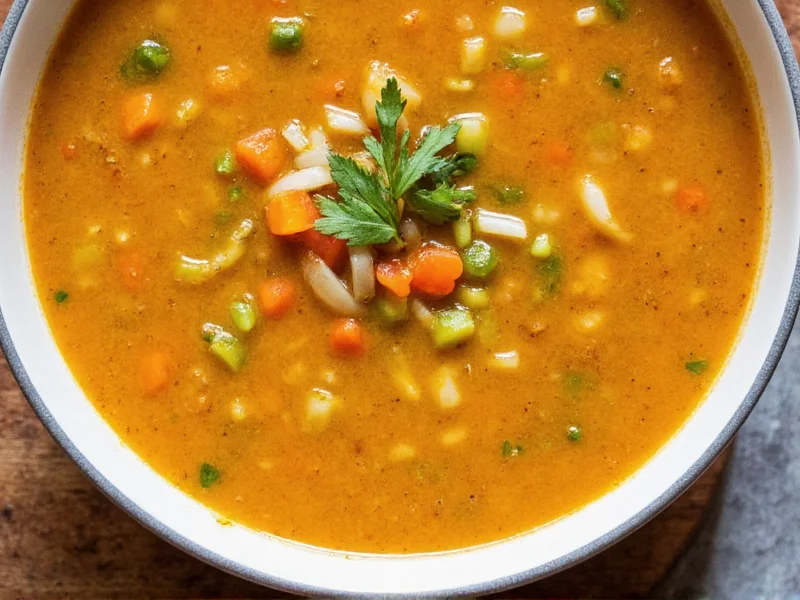The best vegetable soup recipe combines fresh seasonal vegetables, aromatic herbs, and proper cooking techniques for maximum flavor. This simple, nutritious recipe serves 6, requires 45 minutes total time, and uses common pantry ingredients. Start by sautéing onions, carrots, and celery in olive oil until softened, then add garlic, diced tomatoes, vegetable broth, potatoes, and your choice of seasonal vegetables. Simmer for 25 minutes until tender, season with herbs, and finish with a splash of lemon juice for brightness.
Why This Vegetable Soup Recipe Works
Creating exceptional vegetable soup isn't just about throwing ingredients together—it's about understanding flavor development and proper technique. Many home cooks make the mistake of adding all vegetables at once, resulting in uneven cooking. The secret to restaurant-quality vegetable soup lies in staged vegetable addition based on cooking times. Root vegetables like potatoes and carrots need longer to soften than delicate greens or zucchini, which can turn mushy if overcooked.
Essential Ingredients for Perfect Vegetable Soup
The foundation of any great vegetable soup recipe starts with quality ingredients. While you can adapt based on seasonal availability, these components create balanced flavor:
| Ingredient Category | Key Components | Why It Matters |
|---|---|---|
| Aromatic Base | Onion, carrots, celery (mirepoix), garlic | Creates flavor foundation through caramelization |
| Broth/Liquid | Low-sodium vegetable broth (4-6 cups) | Quality broth makes or breaks the soup's depth |
| Root Vegetables | Potatoes, parsnips, turnips | Add heartiness and natural sweetness when cooked |
| Quick-Cook Veggies | Zucchini, green beans, peas, spinach | Add texture and color without becoming mushy |
| Flavor Enhancers | Tomatoes, herbs, lemon juice, Parmesan rind | Builds complexity and balances flavors |
Step-by-Step Vegetable Soup Preparation
Follow these professional techniques for the best homemade vegetable soup:
- Sauté aromatics properly: Heat 2 tbsp olive oil over medium heat. Add 1 diced onion, 2 chopped carrots, and 2 celery stalks. Cook 8-10 minutes until softened but not browned.
- Add garlic and tomatoes: Stir in 3 minced garlic cloves and 1 (14.5oz) can diced tomatoes with juices. Cook 2 minutes until fragrant.
- Build flavor with liquids: Pour in 4-6 cups low-sodium vegetable broth, scraping the bottom to release flavorful bits.
- Add long-cooking vegetables: Include 2 diced potatoes, 1 chopped parsnip, and 1 bay leaf. Simmer 15 minutes.
- Add medium-cooking vegetables: Stir in 1 diced zucchini, 1 cup green beans, and 1 cup chopped cabbage. Simmer 8 minutes.
- Finish with delicate ingredients: Add 1 cup fresh spinach, 1/2 cup peas, and 1 tbsp chopped fresh parsley. Cook 2-3 minutes.
- Season perfectly: Remove bay leaf. Stir in 1 tbsp lemon juice, 1 tsp dried thyme, salt and pepper to taste.
Pro Tips for Vegetable Soup Success
Achieve restaurant-quality results with these professional kitchen insights:
- Don't rush the mirepoix: Taking time to properly soften onions, carrots, and celery builds the flavor foundation. Rushing this step creates a flat-tasting soup.
- Acid is essential: The splash of lemon juice or vinegar at the end brightens flavors and balances richness—don't skip this crucial step.
- Use a Parmesan rind: Adding a leftover Parmesan cheese rind while simmering adds umami depth without making the soup cheesy.
- Season in layers: Add small amounts of salt throughout cooking rather than all at the end for better flavor integration.
- Cool before storing: Let soup cool to room temperature before refrigerating to maintain vegetable texture.
Customizing Your Vegetable Soup Recipe
This versatile base recipe adapts beautifully to seasonal ingredients and dietary needs:
Seasonal Variations
- Spring: Asparagus, fresh peas, baby carrots, and fresh herbs
- Summer: Tomatoes, zucchini, corn, and fresh basil
- Fall: Butternut squash, sweet potatoes, kale, and sage
- Winter: Turnips, parsnips, cabbage, and rosemary
Dietary Adaptations
- Gluten-free: Naturally gluten-free—just ensure your broth is certified GF
- Vegan: Use vegetable broth and omit Parmesan rind
- Lower-carb: Reduce potatoes, increase cauliflower and broccoli
- Protein boost: Add white beans, lentils, or chickpeas during final simmer
Storage and Reheating Instructions
Proper storage maintains flavor and texture for future enjoyment:
- Refrigeration: Store in airtight container for up to 5 days
- Freezing: Freeze in portion-sized containers for up to 3 months (leave headspace for expansion)
- Reheating: Warm gently over medium-low heat, stirring occasionally. Add splashes of broth or water if too thick.
- Flavor development: Vegetable soup often tastes better the next day as flavors meld—plan ahead when possible!
Frequently Asked Questions
Can I make vegetable soup without broth?
Yes, you can create flavorful vegetable soup without broth by using water with added umami boosters. Include ingredients like tomato paste (sautéed with aromatics), dried mushrooms, soy sauce (1-2 tsp), nutritional yeast, or a Parmesan cheese rind. The key is building layers of flavor since you're missing the broth's depth.
How do I prevent vegetables from becoming mushy?
Add vegetables in stages based on cooking time. Start with root vegetables (potatoes, carrots), then medium-cooking vegetables (celery, beans), and finally delicate vegetables (spinach, peas). Cut vegetables to uniform sizes for even cooking. For meal prep, slightly undercook vegetables before storing, as they'll continue softening when reheated.
What's the best way to thicken vegetable soup?
For a naturally thickened vegetable soup without flour or cornstarch, try these methods: blend 1-2 cups of the finished soup and stir back in, add mashed potatoes or white beans, or include a small amount of pearl barley during cooking. Avoid over-thickening—vegetable soup should have a brothy consistency, not be stew-like.
Which herbs work best in vegetable soup?
Classic herb combinations include thyme and bay leaf for foundational flavor, rosemary for heartier winter vegetables, and dill or parsley for lighter spring/summer versions. Add dried herbs early in cooking to release flavors, but stir in fresh herbs during the last 5 minutes to preserve their brightness. A small amount of oregano (1/4 tsp) can add complexity without overpowering.











 浙公网安备
33010002000092号
浙公网安备
33010002000092号 浙B2-20120091-4
浙B2-20120091-4